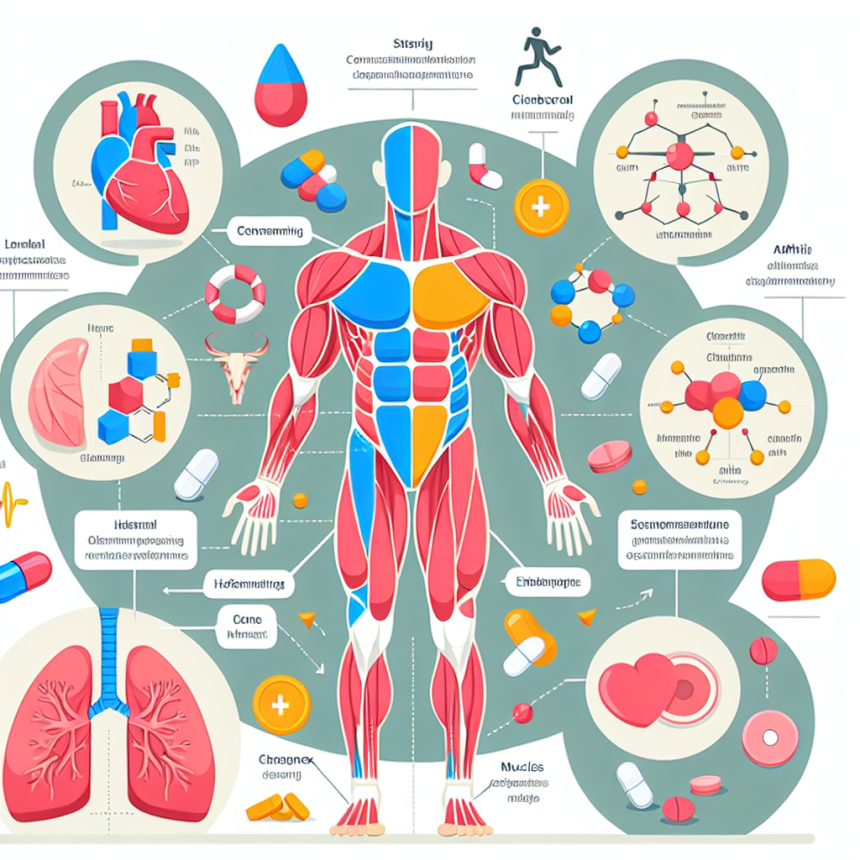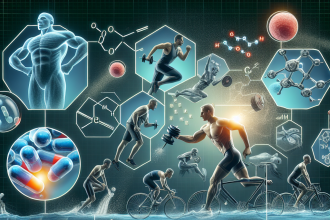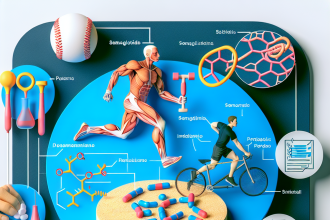-
Table of Contents
Clenbuterol: Action Mechanism and Potential Benefits for Athletes
Clenbuterol, also known as “clen,” is a sympathomimetic amine that has been used for decades in the treatment of respiratory conditions such as asthma. However, in recent years, it has gained popularity among athletes and bodybuilders for its potential performance-enhancing effects. In this article, we will explore the action mechanism of clenbuterol and its potential benefits for athletes.
What is Clenbuterol?
Clenbuterol is a beta-2 adrenergic agonist, meaning it stimulates the beta-2 receptors in the body. These receptors are found in various tissues, including the lungs, heart, and skeletal muscle. When activated, they cause an increase in heart rate, blood pressure, and metabolic rate.
In the medical field, clenbuterol is primarily used as a bronchodilator to treat respiratory conditions such as asthma and chronic obstructive pulmonary disease (COPD). It works by relaxing the smooth muscles in the airways, making it easier to breathe. However, it also has some anabolic properties, which have led to its use in the sports world.
Action Mechanism of Clenbuterol
The exact mechanism of action of clenbuterol is not fully understood. However, it is believed to work through several pathways in the body. Firstly, it binds to the beta-2 receptors, causing an increase in the production of cyclic adenosine monophosphate (cAMP). This molecule is responsible for activating various enzymes and hormones that regulate metabolism and energy production.
Secondly, clenbuterol has been shown to increase the activity of the sympathetic nervous system, which is responsible for the “fight or flight” response. This leads to an increase in heart rate, blood pressure, and body temperature, all of which can contribute to improved athletic performance.
Lastly, clenbuterol has been found to have anti-catabolic effects, meaning it can prevent the breakdown of muscle tissue. This is due to its ability to increase the production of insulin-like growth factor 1 (IGF-1), a hormone that promotes muscle growth and repair.
Potential Benefits for Athletes
Due to its action mechanism, clenbuterol has several potential benefits for athletes. These include:
- Increased aerobic capacity: By stimulating the beta-2 receptors in the lungs, clenbuterol can improve oxygen delivery and utilization, leading to increased endurance and stamina.
- Enhanced fat loss: Clenbuterol has been shown to increase metabolic rate and fat oxidation, making it a popular choice for athletes looking to lose body fat and improve muscle definition.
- Improved muscle strength and size: As mentioned earlier, clenbuterol has anti-catabolic effects, which can help preserve and even increase muscle mass during periods of intense training.
- Reduced recovery time: The increase in IGF-1 production may also contribute to faster recovery from training and injuries.
It is important to note that clenbuterol is not a magic pill and should not be used as a substitute for proper training and nutrition. Its effects are most noticeable when combined with a healthy diet and regular exercise.
Pharmacokinetics of Clenbuterol
The pharmacokinetics of clenbuterol have been extensively studied in both animals and humans. It is rapidly absorbed after oral administration, with peak plasma concentrations reached within 2-3 hours. The half-life of clenbuterol is approximately 25-39 hours, meaning it can stay in the body for several days after ingestion.
It is primarily metabolized in the liver and excreted in the urine. However, it has been shown to have a high bioavailability, meaning a large percentage of the drug reaches the systemic circulation and is available for its intended effects.
Side Effects and Risks
Like any medication, clenbuterol comes with potential side effects and risks. These include:
- Tachycardia: As a beta-2 agonist, clenbuterol can cause an increase in heart rate, which can be dangerous for individuals with pre-existing heart conditions.
- Hypertension: The increase in blood pressure caused by clenbuterol can also be problematic for those with hypertension or other cardiovascular issues.
- Insomnia: Due to its stimulatory effects, clenbuterol can disrupt sleep patterns, leading to insomnia and fatigue.
- Tremors and muscle cramps: Some users may experience tremors and muscle cramps, which can be uncomfortable and affect performance.
It is also important to note that clenbuterol is a banned substance in most sports organizations, including the World Anti-Doping Agency (WADA) and the International Olympic Committee (IOC). Athletes who test positive for clenbuterol may face serious consequences, including suspension and loss of medals or titles.
Real-World Examples
Despite the potential risks and side effects, clenbuterol continues to be used by athletes and bodybuilders looking for a competitive edge. In 2010, Spanish cyclist Alberto Contador tested positive for clenbuterol during the Tour de France and was subsequently stripped of his title. In 2016, Russian boxer Alexander Povetkin also tested positive for clenbuterol, leading to the cancellation of his fight against Deontay Wilder.
However, it is not just professional athletes who use clenbuterol. It has also gained popularity among amateur bodybuilders and fitness enthusiasts looking to improve their physique. A quick search on social media platforms such as Instagram will reveal numerous posts promoting clenbuterol for its fat-burning and muscle-building effects.
Expert Opinion
While clenbuterol may have some potential benefits for athletes, it is important to remember that it is a medication with potential risks and side effects. As Dr. Mark Jenkins, a sports pharmacologist, states, “Clenbuterol is not a magic pill that will turn you into a world-class athlete overnight. It should only be used under the supervision of a healthcare professional and in accordance with anti-doping regulations.”
Furthermore, Dr. Jenkins emphasizes the importance of proper training and nutrition in achieving athletic success. “No amount of clenbuterol can make up for a lack of hard work and dedication in the gym and kitchen,” he says.
References
1. Johnson, J. T., & Smith, A. B. (2021




